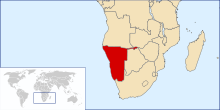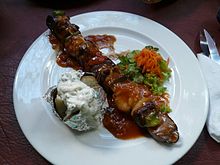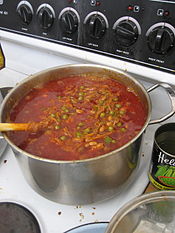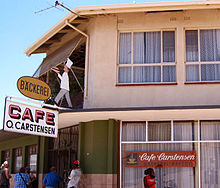- Namibian cuisine
-
 Location of Namibia
Location of Namibia
Namibian cuisine is the cuisine of Namibia. It is influenced by two primary cultural strands:
- Cookery practised by indigenous people of Namibia such as the Himba, Herero and San groups
- Settler cookery introduced during the colonial period by people of German, Afrikaner and British descent.
Contents
Indigenous cookery
In the precolonial period indigenous cuisine was characterised by the use of a very wide range of fruits, nuts, bulbs, leaves and other products gathered from wild plants and by the hunting of wild game. The domestication of cattle in the region about two thousand years ago by Khoisan groups enabled the use of milk products and the availability of meat. However, during the colonial period the seizure of communal land in Namibia helped to discourage traditional agriculture and reduced the extent of land available to black people.
Settler cookery
Namibia was settled by German colonists during the nineteenth century, and German influence on white Namibian cookery remains very strong. One example of German settler cuisine is Wiener schnitzel.
Brewing
The German brewing tradition continued in colonial German South West Africa, with German lager beers including Hansa and Windhoek lagers still brewed in the country for domestic consumption and export.
See also
References
- Brown, J., 1954. The Thirsty Land, Hodder & Stoughton, London, United Kingdom.
- Van Wyk, B. and Gericke, N., 2000. People's plants: A guide to useful plants of Southern Africa, Briza, Pretoria, South Africa.
- Routledge Encyclopaedia of Africa - Farming
- Wylie, D., 2001. Starving on a Full Stomach: Hunger and the Triumph of Cultural Racism in Modern South Africa, University of Virginia Press, Charlottesville, VA., United States of America.
African cuisine National cuisines - Algeria
- Angola
- Benin
- Botswana
- Burkina Faso
- Burundi
- Cameroon
- Cape Verde
- Centrafrican (Central African Republic)
- Chad
- Comoros
- The Republic of the Congo
- The Democratic Republic of the Congo
- Egypt
- Eritrea
- Ethiopia
- Gabon
- Ghana
- Ivorian (Côte d'Ivoire)
- Kenya
- Libya
- Madagascar
- Morocco
- Mozambique
- Namibia
- Nigerien (Niger)
- Nigerian
- Rwanda
- Senegal
- Sierra Leone
- Somalia
- South Africa
- Sudan
- Swaziland
- Tanzania
- Tunisia
- Uganda
- Zambia
- Zimbabwe
Ethnic and regional cuisines 
This African cuisine-related article is a stub. You can help Wikipedia by expanding it.




